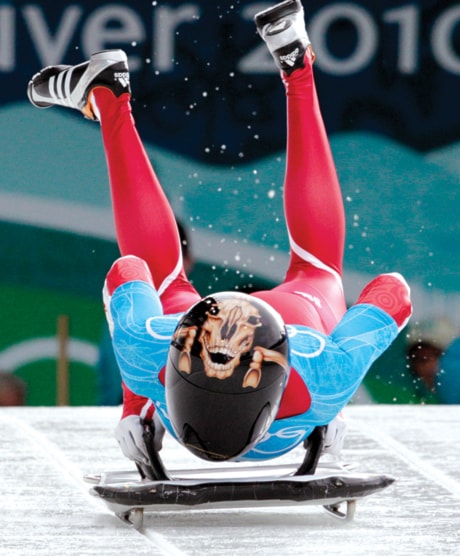WHISTLER, B.C. — Defending Olympic gold medal skeleton racer Maya Pedersen says it’s unfair for the luge sports governing body to solely blame Georgian slider Nodar Kumaritashvili for the crash that took his life at the Whistler Sliding Centre.
Pedersen said the changes made to the profile of the ice at the fatal turn 16 were needed earlier.
“If they hadn’t (since) changed it, I would have flipped twice today,” said Pedersen after the skeleton racers took their first runs to prepare for the Olympic competition, which runs Thursday and Friday.
“It’s sad to hear that they’re just blaming the athlete, that he made a mistake. I’m a good athlete and I made the same mistake twice now.”
The 27-year-old slider from Spiez made the comments Monday as the International Bobsleigh Federation, or FIBT, offered skeleton racers an extra training run further down the course as a safety measure.
About a third of the athletes in both men’s and women’s training heats took them up on it.
A spokesman for the FIBT said the idea was to help all athletes simply feel a little more comfortable.
“It’s impossible for people to have a lot of training on every single track in the world, so you have to create opportunities when it’s necessary,” said Don Krone in a news release.
Kumaritashvili died Friday when his sled flew out from under him on the final, high-speed corner during training. Rather than remain in the track, his body flew up and over the wall, slamming his head into a metal support pillar. He was declared dead within an hour.
As a result, the International Luge Federation, or FIL, the governing body for that sport, ruled that Kumaritashvilli, a 21-year-old with limited experience, took a poor line into the corner, subjecting his body to such overwhelming G-forces he was at the mercy of the sled.
Nevertheless, the FIL changed the ice profile of the corner to better keep sliders in the track and also built up the retaining walls around it. It also ordered luge sliders in all disciplines to start further down the course to reduce speed.
The decision was criticized by some sliders as a needless, knee-jerk reaction that gutted the integrity of the competition by making the course too easy.
Pedersen said the changes are a big improvement.
“(The corner) is no longer a hot tub,” she said. “It’s shaped 90 degrees.
“If they had shaped it like that before, maybe Kumaritashvili would just have hurt himself (and not died).”
Canada’s Mellisa Hollingsworth, the No. 1 ranked slider in the world and a gold medal favourite, roared down the track Monday to place first in both training heats.
The 27-year-old from Eckville said she has not looked at video footage of the death crash.
“I didn’t see the run. I’m choosing not to look at the run. As far as the track is concerned, this is a wonderful track and we’re sliding at this Olympic level, the most elite level, and I feel I want to be challenged.
“You can only slide on a track like Igls, Austria, for so long and you want to be challenged. You want to push your limits.”
Canadian Michelle Kelly said a number of corners, not just 16, can be challenging.
“I came up once and it looked like I got attacked by a cougar. I ripped my seat open and had a couple of nicks in my helmet, but it was my own fault.”
She said the accident was regrettable, but said “it reinforces what we do is dangerous.
“I do feel that the track is safe. I think it was just a real unfortunate incident.”
Jon Montgomery of Russell, Man., said the it’s hard to compare skeleton with luge.
“The dynamics of their sport is completely different from our own,” he said. “They’re a lot more elevated (in the sled), they can tip off their sleds, they’re going down feet-first as opposed to head first, they’re on blades and were on round bars. It’s a completely different monster.
“(Turn) sixteen is fine, especially for our sport.”
Montgomery, 30, was the top men’s slider in both heats Monday. The 30-year-old is ranked fifth in the world.
Toronto slider Mike Douglas said the reality is the Olympics have a mix of athletes, some at the elite level with World Cup bona fides and legitimate medal aspirations and those who are effectively here for the experience.
“I don’t know where their head space is at, but if they’re trying to keep up with guys who have great control and great equipment, they’re not on the same playing field. And I think that’s (true) with any sport.”
American slider Zach Lund said the FIL decision was predictable.
“They did exactly what I thought they would do, and that is overreact.”
“You never want anything like that to happen, but sometimes I think people forget we’re hurling ourselves down a chute of ice at 80 mph on a technical course and things can happen. They can happen in all sports.”
